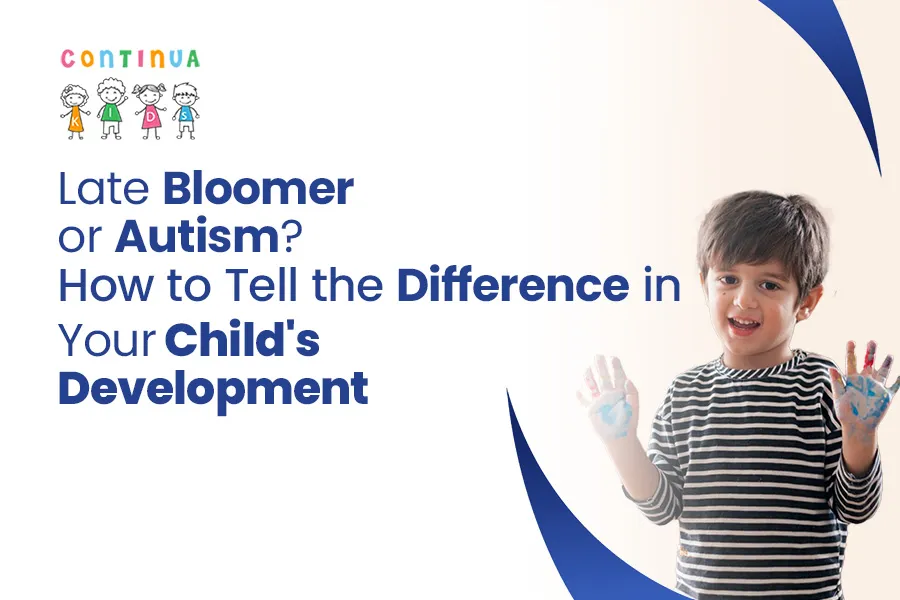
Late Bloomer or Autism? How to Tell the Difference in Your Child's Development
Neurologically, a child’s brain grows tremendously in the first five years of life. Speech, emotions, social skills, it all begins during this period of time. It is what experts refer to as the “critical window of development” as their brains are busy wiring and tuning connections based on everyday moments and loving attention.
Every parent hopes their child reaches milestones “on time” like crawling, talking, and making friends.
But what if your child takes longer, are they called as late bloomer kids? Or something more, like autism? These questions are hard and can hurt your heart. You just want the best.
Let’s get started. Read More
Understanding Developmental Delays and What "Late Bloomers" Are
Some kids take a little more time to grow certain skills. This is called developmental delay. A child might walk at 18 months instead of 12 months. That can be okay.
Here’s what being a late bloomer might look like:
- They learn to talk or walk a little later than others their age.
- They are curious and observant, just not very vocal.
- They eventually catch up on their own, without therapy or help.
Developmental Milestones by Age (Typical)
| Age | Milestone | What You Might Notice |
|---|---|---|
| 6 months | Smiles, makes sounds | Laughs, turns to voices |
| 12 months | Says “mama” or “dada” | Waves bye-bye, crawls |
| 18 months | Walks, points, says words | Imitates you, shows interest in others |
| 24 months | Says 2-word phrases like “more juice” | Plays with toys properly |
| 36 months | Talks in simple sentences | Pretend play, shows feelings |
But What If It’s Autism?
Autism is a neurodevelopmental condition that means the brain works differently from the start.
Kids with autism may not grow out of their delays without support. The signs are often visible by age 2, though some show earlier or later. Read More
What Is Autism?
- It affects social skills, communication, and behavior.
- Called a “spectrum” because it looks different/unique in every child.
- Some kids don’t speak while some speak a lot but can’t understand emotions.
- Some kids love hugs and others don’t like being touched at all.
Late Bloomer or Autism? Key Differences
Here’s a helpful comparison to understand if it’s a late bloom or autism.
Comparison Table: Late Bloomer vs. Autism

Early Signs of Autism vs Normal Developmental Delays
1. Communication
Late Bloomer:
- May say words late but tries to imitate sounds.
- Can point or use gestures to show needs.
Autism:
- May not try to communicate, even with gestures.
- Repeats words (echolalia) without meaning.
- Doesn’t babble by 12 months.
2. Social Interaction
Late Bloomer:
- Enjoys being held, played with, smiled at.
- Learns to engage with others over time.
Autism:
- Generally try to stay alone, doesn’t talk or make eye contact.
- Doesn’t respond to facial expressions or social games.
Add Your Heading Text Here
Late Bloomer:
- Starts pretend play a little late.
- May prefer toys over people at times.
Autism:
- Lines up toys, spins wheels, or flaps hands repeatedly.
- Rarely shows pretend play (e.g., feeding a doll).
Late Bloomer Red Flags by Age
12 Months
Okay to Wait If:
- No clear words yet
- But: Baby babbles, makes eye contact, uses gestures (like waving, pointing)
Talk to a Doctor If:
- No babbling at all
- Doesn’t respond to name
- Doesn’t point or show interest in people or things
18 Months
Okay to Wait If:
- Says 5–10 words
- Tries to imitate sounds
- Uses gestures to express needs
Talk to a Doctor If:
- Says no words
- Doesn’t play pretend
- Doesn’t copy adults or show interest in play
24 Months
Okay to Wait If:
- Has around 50 words
- Begins to use 2-word phrases like “Want chocolate”
Talk to a Doctor If:
- Says fewer than 50 words
- Doesn’t combine words
- Avoids eye contact, doesn’t follow instructions
36 Months
Okay to Wait If:
- Speech is simple, may not be perfect
- Talks in 3-word sentences
- Tries to play with others
Talk to a Doctor If:
- Unable to speak properly
- Doesn’t show interest in his/her surroundings
- Has rigid routines or strong resistance to change
How You Can Support Your Child Right Now
Speak to Them Often
- Describe what you're doing.
- Label emotions: “You look happy!” or “That scared you.”
Play Together
- Follow their lead.
- Join their games, even if they’re quiet or unusual.
Use Visuals
- Pictures can help explain what’s next (e.g., brushing teeth, bedtime).
- Helps all kids, especially those with autism.
Be Patient
- Repeat things gently.
- Give extra time to respond.
Step-by-Step Approaches for Developmental Delays in toddlers
1. Noticing the Delay
It starts when you or your child’s doctor notices something is a little behind.
Maybe your child isn’t talking like others their age.
Or maybe they don’t play with other children much.
This is when parents often ask: “Should I wait, or get help now?”
2. Getting a Developmental Screening
Your doctor may suggest a developmental screening.
This is a short test to check how your child is growing and learning.
It covers speech, movement, social interaction, and play.
3. Getting a Full Evaluation
An expert, like a child psychologist or developmental pediatrician, will spend time with your child.
They’ll play, talk, and observe.
You’ll also answer questions about your child’s behavior and milestones.
The goal is to understand if it’s just a delay or something else like autism.
4. Making a Therapy Plan
If your child is a late bloomer, the team may still suggest therapy.
This doesn’t mean anything is “wrong.” It just means extra help can support your child’s growth.
They may recommend speech therapy, occupational therapy, or play-based early intervention.
5. Starting Therapy Sessions
Therapy is often once or twice a week.
It can take place at a clinic, school, or even right at home.
The sessions are focused on simple goals. It can include helping your child use more words or ask for help.
Therapy is like guided play. Your child may not even know they’re learning.
6. Getting Involved as a Parent
You are part of the therapy too.
Therapists will show you small things to do at home like how to encourage speech during snack time or how to handle tantrums with calm words.
The more support at home, the more your child grows.
7. Checking Progress Over Time
Every few months, your therapist or doctor will check how things are going.
If more support is needed, the team will adjust the plan.
FAQs: What Parents Ask Most Often
Autism isn’t something to “outgrow,” but many children learn new skills with support.
No. Some kids talk late but catch up without autism signs.
It feels scary, yes. But diagnosis helps you understand your child better and get help.
We don’t fully know. It may involve genes, brain development, and environment before birth.
Yes! Early therapy leads to stronger communication, social, and life skills.
Conclusion
The brain undergoes extensive development during early childhood. During this period, it creates neural connections at the rate of over one million per second. If your child is a late bloomer, or has autism, they all deserve love, respect and care. They are not “behind”, they are progressing in their own way.
If you’re unsure, ask. Speak to your doctor. Get a developmental checkup because no matter what, early help brings brighter days. And millions of children have grown, and bloomed in their own beautiful ways.
